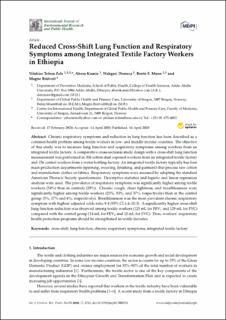| dc.contributor.author | Zele, Yifokire Tefera | |
| dc.contributor.author | Kumie, Abera | |
| dc.contributor.author | Deressa, Wakgari | |
| dc.contributor.author | Moen, Bente Elisabeth | |
| dc.contributor.author | Bråtveit, Magne | |
| dc.date.accessioned | 2021-04-12T13:08:35Z | |
| dc.date.available | 2021-04-12T13:08:35Z | |
| dc.date.created | 2020-05-24T16:57:37Z | |
| dc.date.issued | 2020 | |
| dc.Published | International Journal of Environmental Research and Public Health. 2020, 17 (8), 2741-?. | |
| dc.identifier.issn | 1660-4601 | |
| dc.identifier.uri | https://hdl.handle.net/11250/2737345 | |
| dc.description.abstract | Chronic respiratory symptoms and reduction in lung function has been described as a common health problem among textile workers in low- and middle-income countries. The objective of this study was to measure lung function and respiratory symptoms among workers from an integrated textile factory. A comparative cross-sectional study design with a cross-shift lung function measurement was performed in 306 cotton dust exposed workers from an integrated textile factory and 156 control workers from a water bottling factory. An integrated textile factory typically has four main production departments (spinning, weaving, finishing, and garment) that process raw cotton and manufacture clothes or fabrics. Respiratory symptoms were assessed by adopting the standard American Thoracic Society questionnaire. Descriptive statistics and logistic and linear regression analysis were used. The prevalence of respiratory symptoms was significantly higher among textile workers (54%) than in controls (28%). Chronic cough, chest tightness, and breathlessness were significantly higher among textile workers (23%, 33%, and 37%, respectively) than in the control group (5%, 17% and 6%, respectively). Breathlessness was the most prevalent chronic respiratory symptom with highest adjusted odds ratio 9.4 (95% CI 4.4–20.3). A significantly higher cross-shift lung function reduction was observed among textile workers (123 mL for FEV1 and 129 mL for FVC) compared with the control group (14 mL for FEV1 and 12 mL for FVC). Thus, workers’ respiratory health protection programs should be strengthened in textile factories. | en_US |
| dc.language.iso | eng | en_US |
| dc.publisher | MDPI | en_US |
| dc.rights | Navngivelse 4.0 Internasjonal | * |
| dc.rights.uri | http://creativecommons.org/licenses/by/4.0/deed.no | * |
| dc.title | Reduced Cross-Shift Lung Function and Respiratory Symptoms among Integrated Textile Factory Workers in Ethiopia | en_US |
| dc.type | Journal article | en_US |
| dc.type | Peer reviewed | en_US |
| dc.description.version | publishedVersion | en_US |
| dc.rights.holder | Copyright 2020 by the authors. | en_US |
| dc.source.articlenumber | 2741 | en_US |
| cristin.ispublished | true | |
| cristin.fulltext | original | |
| cristin.qualitycode | 1 | |
| dc.identifier.doi | 10.3390/ijerph17082741 | |
| dc.identifier.cristin | 1812297 | |
| dc.source.journal | International Journal of Environmental Research and Public Health | en_US |
| dc.source.40 | 17 | |
| dc.source.14 | 8 | |
| dc.identifier.citation | International Journal of Environmental Research and Public Health. 2020, 17 (8), 2741. | en_US |
| dc.source.volume | 17 | en_US |
| dc.source.issue | 8 | en_US |

